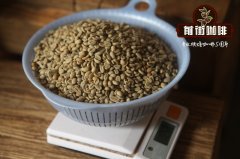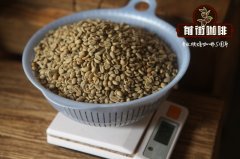Coffee production, origin and planting characteristics in Brazil? What are the flavor and taste characteristics of Brazilian coffee?

Professional coffee knowledge exchange more coffee bean information please follow the coffee workshop (Wechat official account cafe_style)
Coffee production, origin and planting characteristics in Brazil? What are the flavor and taste characteristics of Brazilian coffee?
1 > output: coffee production accounts for 1% of the world's total, making it the largest coffee producer.
< 2 > quality: because the quality of the coffee produced is average, there are few excellent coffee.
Grade coffee beans, so it is generally considered indispensable in mixing and blending.
Less coffee beans.
< 3 > famous varieties: among the many varieties of Brazilian coffee, Santos is more famous, followed by Rio.
< 4 > Taste characteristics: mild, moderate sour and bitter, soft aroma.
< 5 > Best quality producing area: currently in Ribilon and Perodo in the north of S ã o Paulo
Fulangka is the best quality producing area for Brazilian coffee.
Coffee origin: Brazil
Main flavor: hazelnut, citrus, full of sweetness, rich fruit flavor, pure, sweet and mellow, showing multi-level flavor
Variety: Arabica coffee beans
Baking: deep City Baking (Full-city Roast)
Among the many varieties of coffee in Brazil, yellow bourbon is one of the most outstanding varieties of coffee. Generally speaking, yellow bourbon changes from green to yellow to red, but the appearance of yellow bourbon only stays in yellow. The yellow bourbon, which grows at high altitude and is washed, has an excellent flavor.
The nose has a hint of citrus, balanced and supple acidity, rich fruit flavor and hazelnut flavor. This coffee bean has a very high performance-to-price ratio, and its unique sweetness and thickness are better than those commonly used in Brazil. Bourbon species, native to Bourbon Island in the Indian Ocean (now known as Reunion Island), is the second species caused by the Typica mutation. It belongs to the oldest existing coffee variety. The green fruit appears bright red when ripe, while the yellow bourbon species is derived from the cross between bourbon species and other varieties. Because of its low yield and relatively intolerant to wind and rain, it has not been widely planted. But when planted at high altitudes, it will have excellent flavor performance.
Brazil's coffee production once accounted for 60% of the world's total coffee production at the beginning of the 20th century. At present, the average annual output is about 30 million bags (60 kg per bag), accounting for 30% of the global output. Brazil is also known as the "coffee continent" or "coffee kingdom". Although it is the largest producer of coffee, the evaluation is mostly lacklustre, because most of the Brazilian coffee gardens are less than 1200 meters above sea level. There is no lush woodland to provide the necessary shade for Arabica coffee trees, and the way beans are picked is rough, and ripe fruit is harvested together with green fruit, which does not meet the conditions for fine coffee cultivation.
Brazilian coffee is widely grown in flat areas. In order to adapt measures to local conditions, Brazilian landlords have developed improved Arabica coffee trees that do not require highland or shade decades ago, which can be planted on plains or grasslands and directly exposed to the sun, which is different from the traditional method of shade cultivation at higher altitude.
Most of the Brazilian coffee plantations are only a few hundred Michael above sea level, even on flat land. This kind of exposure planting method makes the coffee fruit grow faster, the flavor development is not complete, and the density of beans, that is, the so-called hardness is not as good as plateau beans, the acidity of the fruit is obviously low, the flavor is monotonous, and the coastal Rio coffee even has iodine and salty taste. This flavor is thought to be the result of some kind of microbial action, but even if it is planted in the same soil, it does not necessarily produce this flavor every year. Most coffee hobbies do not appreciate this flavor. Only a few Middle Eastern countries have the habit of sugar and brewing coffee, which is particularly suitable for the flavor of Rio coffee.
Many experts believe that the image of Brazilian coffee is not good. The original culprits include violation of the necessary shading, sun-exposure cultivation and mechanized harvesting of coffee. In addition, Brazilian coffee farmers mostly use labor-free sun treatment. However, there is a reason why Brazil still regularly uses natural drying. First of all, because of the weather, there is not enough water in the production area to cope with the delicate process of producing a large amount of coffee beans. Because of the vast flat terrain unique to Brazil, it is suitable for large-scale production by natural drying. However, it is often due to variables such as humid climate, causing coffee beans to become moldy and produce a rotten smell.
Coffee originated in Ethiopia in Africa and was introduced into Brazil in 1727. Brazil is located in the southeast of South America, located in the tropics and subtropics, the unique geographical and climatic conditions are suitable for growing coffee, coupled with cheap labor, coffee growing industry is booming. In the 19th century, coffee was grown almost all over the country, followed by a "coffee boom" that lasted nearly a century. The extensive cultivation of coffee has brought wealth and prosperity to Brazil. At the beginning of the 20th century, Brazil's coffee production accounted for more than 75% of the world's total output, thus winning the laudatory name of "coffee kingdom".
Coffee is one of the important pillars of Brazil's national economy. There are 500000 coffee plantations, large and small, with a planting area of about 2.2 million hectares, a working population of more than 6 million, an annual output of about 2 million tons of coffee, and an annual export earnings of nearly 2 billion US dollars. In recent years, Brazilian coffee production and exports have declined due to changes in the export structure and the downturn in the international coffee market. Brazilians love coffee. In the 1960s, Brazil's per capita annual coffee consumption reached 5.8 kilograms. In the past two decades, with the emergence of other drinks, the per capita coffee consumption in Brazil is still more than 3 kilograms. In Brazil, all kinds of coffee houses can be seen everywhere in both urban and rural areas. People can drink hot coffee with strong fragrance almost anytime and anywhere.
Although Brazilian coffee is the largest coffee producer in the world. However, coffee connoisseurs do not think highly of Brazilian beans, saying that Brazilian coffee is too monotonous, not sour, not fragrant or bitter, lacks personality beauty, and does not even put Brazil on the list of fine coffee producers. For many years, Brazilian coffee farmers have struggled to increase their market share at the expense of quality. Brazilian coffee beans have become a cheap choice for beginners to taste coffee.
However, Brazilian coffee beans are the most suitable choice for every kind of mixed coffee. If you want to produce an elegant and inexpensive mixed coffee, affordable Brazilian coffee is a good foil. Use a lot of Brazilian coffee and balance other coffee varieties with strong flavor, such as Mamba Coffee and Momba Coffee. Wait. All choose Brazilian coffee as the best choice.
Not all coffee produced in Brazil can not be included in the list of boutique coffee at an affordable price. The well-known Brazilian coffee beans generally refer to Santos (Santos or Santos). In fact, there is a best variety in Brazil, but the yield is very small. This kind of coffee bean is produced by a coffee tree called Bourbon strain of Coffee Arabica (Arabica bourbon). Although the beans harvested in the first four or five years are small and round, they taste very good, with fine acidity and sweetness, but after several harvests. Coffee beans will become bigger and lose some flavor, and at this time the coffee is called flat bean Santos (flat bean mountain toast).
Another kind of coffee is also quite well-known called Cerrado (Hirado), which is widely grown at an altitude of about 1100 meters, and the annual average temperature is only about 20 ℃. The soil layer belongs to a gravel layer, similar to the soil quality of French vineyards, which is conducive to drainage and retention of nutrients. Due to the distinct dry and wet seasons and comfortable low temperature, the flavor is very different from the well-known Brazilian coffee bean flavor.
In recent years, Brazil has also begun to introduce water-washed and semi-washed coffee treatment, which contributes to the production of high-quality coffee beans and avoids the problem of uneven drying in the sun. I am optimistic about the future development of Brazilian coffee. After all, it is a luxury to let the public stop tasting coffee. I think Brazilian coffee takes the biggest credit.
Important Notice :
前街咖啡 FrontStreet Coffee has moved to new addredd:
FrontStreet Coffee Address: 315,Donghua East Road,GuangZhou
Tel:020 38364473
- Prev

What are the flavor and taste characteristics of Brazilian coffee Santos coffee beans? Is the Brazilian coffee good?
Professional coffee knowledge exchange more coffee bean information please follow the coffee workshop (Wechat official account cafe_style) Brazilian coffee Santos coffee beans flavor and taste characteristics? Coffee beans-SANTOS, large, light green or yellowish beans, because local beans are mostly sun-treated, with brown cracks in the middle, and are almost always used for blending. Fragrance; fragrance
- Next

What are the flavor and taste characteristics of the black diamond treated by the Akaia species of coffee beans in the Hilado region of Brazil?
Professional coffee knowledge exchange more coffee bean information please follow the coffee workshop (Wechat official account cafe_style) Brazil Coffee Hilado coffee beans Akaia species sun-treated black diamond flavor and taste characteristics? Brazil Xilado producing area Akaia species tanning treatment of black diamond Brazil Cerrado Acaia Natural Black Diamond Brazil has been a global Allah in recent years
Related
- Detailed explanation of Jadeite planting Land in Panamanian Jadeite Manor introduction to the grading system of Jadeite competitive bidding, Red bid, Green bid and Rose Summer
- Story of Coffee planting in Brenka region of Costa Rica Stonehenge Manor anaerobic heavy honey treatment of flavor mouth
- What's on the barrel of Blue Mountain Coffee beans?
- Can American coffee also pull flowers? How to use hot American style to pull out a good-looking pattern?
- Can you make a cold extract with coffee beans? What is the right proportion for cold-extracted coffee formula?
- Indonesian PWN Gold Mandrine Coffee Origin Features Flavor How to Chong? Mandolin coffee is American.
- A brief introduction to the flavor characteristics of Brazilian yellow bourbon coffee beans
- What is the effect of different water quality on the flavor of cold-extracted coffee? What kind of water is best for brewing coffee?
- Why do you think of Rose Summer whenever you mention Panamanian coffee?
- Introduction to the characteristics of authentic blue mountain coffee bean producing areas? What is the CIB Coffee Authority in Jamaica?

